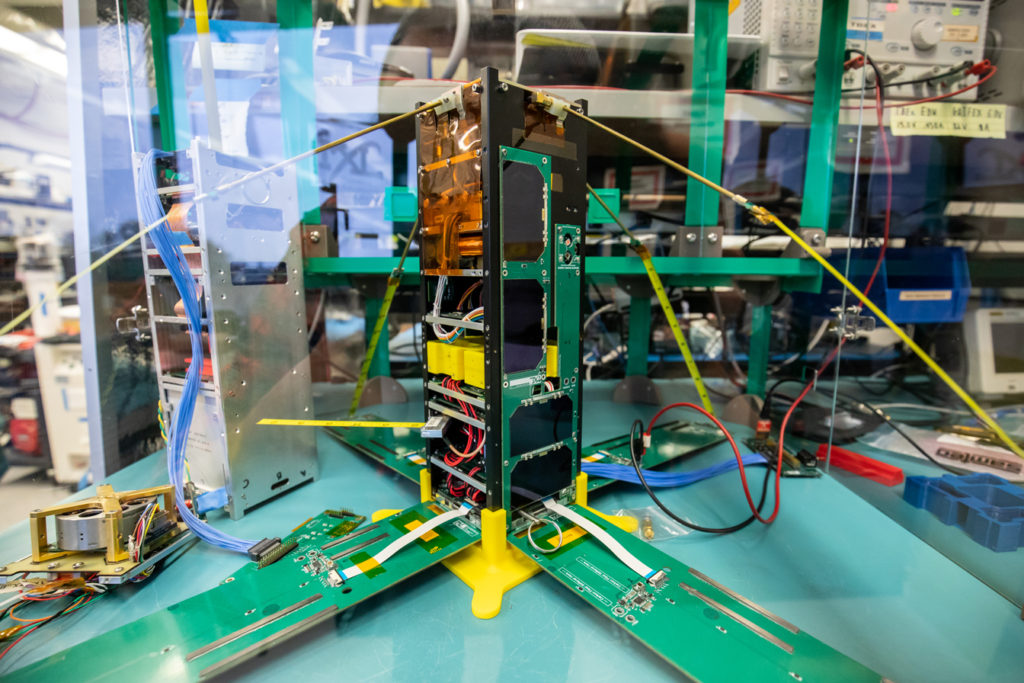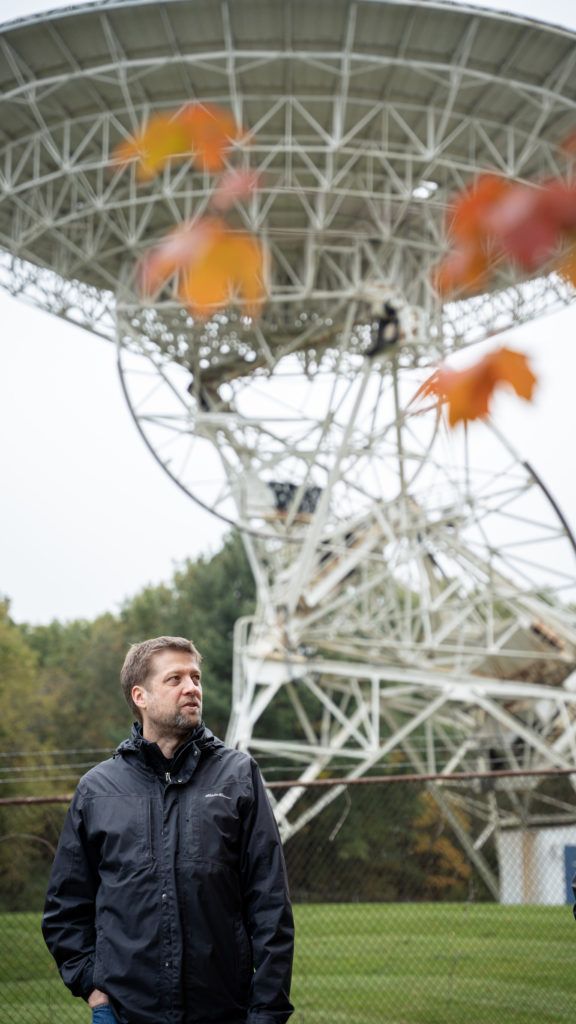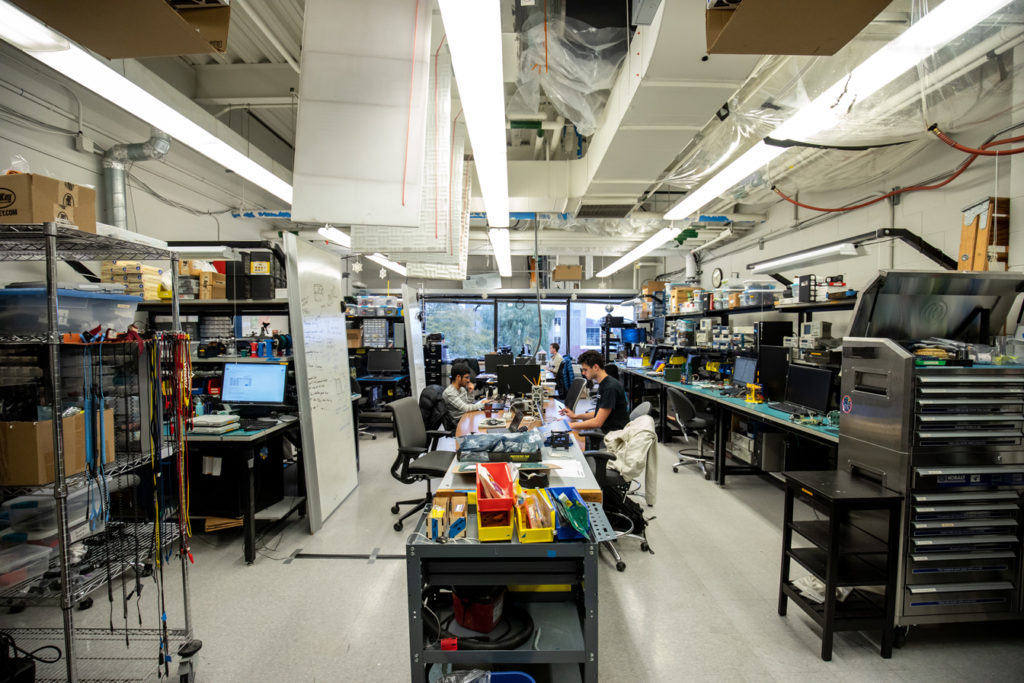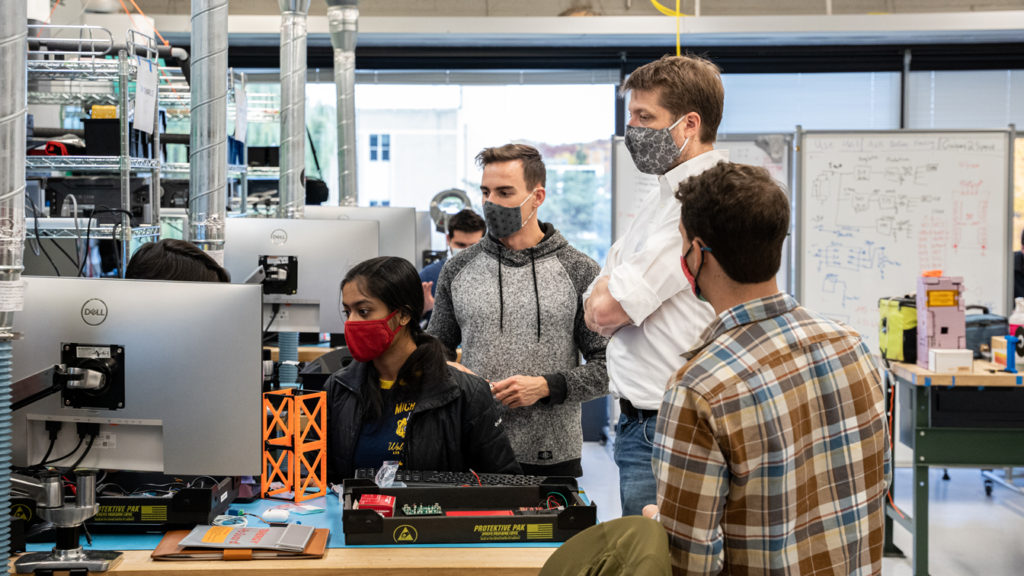
The box that rocked the universe
Meet the U-M researcher who helped pioneer the CubeSat—and a new era in space exploration.
Written by:
Story by Julie Halpert, Photos by Levi Hutmacher, Graphics by Mathias-Philippe Badin
Many of us imagine our role models as larger than life. But Jamie Cutler’s are pocket-sized—the tiny Lego astronauts he grew up with. He recalls a scene from “The Lego Movie” where both the Batmobile and Wonder Woman’s invisible plane have been destroyed and Blue Astronaut finally gets to realize his lifelong dream—building a spaceship to save the world.
“He goes crazy because he gets to build a spaceship,” said Cutler, an associate professor of aerospace engineering at U-M. Cutler sees himself as a bit like that astronaut, a master builder but also “a functioning cog in something bigger.” He explains that the blue astronaut is like an old friend and is a little beat up, “just like the rest of us. Though we may be a little crazy, we all have some skills, some inherent worth, that other people need.”

Perhaps it’s not surprising that Cutler has spent much of his career working with similarly pint-sized spacecraft. He worked with Stanford University professor Bob Twiggs to pioneer the first CubeSat mission in 1999, and interest in the toaster-sized satellites has exploded in recent decades. According to Bryce Space and Technology, the number of satellites in operation more than doubled from 1,381 in 2015 to 3,371 by the end of 2020. Cutler estimates that nearly all of the world’s approximately 100 annual rocket launches carry CubeSats as part of their cargo.
Inexpensive and accessible, CubeSats can be as small as a ten-centimeter cube, and they don’t require their own launch vehicles, instead hitching a ride as secondary cargo on existing rocket launches. That makes them revolutionary in the way they allow nearly anyone to participate in space exploration, something that was previously the exclusive realm of major, well-resourced agencies. They also offer a way to pursue missions that would be too risky or costly for traditional spacecraft.
The private research company Planet, for example, is using a constellation of more than 180 camera-equipped CubeSats to capture photographs of the entire earth every day. “Traditional spacecraft don’t have that ability. It would be far too expensive,” Cutler said. But he explains that it’s easy to add modern digital camera photography capability to a CubeSat. Planet plans to use the data to monitor planet-wide phenomena like water flow, ice and forests—all pivotal in studying climate change impacts.

Elon Musk’s SpaceX has been carrying CubeSats on its rockets for years, and it recently became more involved with the technology after acquiring Swarm Technologies, which was founded by Cutler’s first PhD student, Sara Spangelo (MSE AERO ’10, PhD ’13). Swarm provides global Internet of Things connectivity, which will complement the global internet that SpaceX is building with its Starlink program. Teachers, universities, government agencies, private companies and tech developers have also been working in recent years to make it easier for non-experts to build and launch CubeSats. The U.S. Department of Education’s CTE Mission: CubeSAT, for example, is helping schools overcome financial barriers. Cuter said the CTE mission is a great example of a competition to inspire the next generation of space explorers.
CubeSats are a centerpiece of Michigan Engineering’s new Space Institute, where Cutler is the Lead for Education and Curriculum. The Institute aims to encourage groups across campus to coordinate and work together on multi-disciplinary space-related challenges. Cutler is passionate about what CubeSats will teach us, both as a society and in terms of our young people.
NASA is also working to get more CubeSats into orbit. In April of 2021, the space agency chose 14 CubeSats that will fly as auxiliary payloads on rockets launching between 2022 and 2025. NASA’s CubeSat Launch Initiative provides assistance in getting the CubeSats into orbit, including a manual on how CubeSats work, designed for the average person who is interested in pursuing them. “Pretty much anybody in the world can develop a mission idea, and work with entrepreneurs and rocket builders, and get that to work,” Cutler said.
CubeSats, he says, have become a “game changer because they basically opened up the door to providing easier access to space.”
To him, it recalls his childhood building plastic, balsa and Styrofoam model airplanes. “All of us look up at the stars with a sense of wonder,” Cutler said.

Nuts and Bolts
Each ten-centimeter CubeSat can stand on its own or connect like Legos with other units to make a larger satellite. Cutler demonstrates this by holding up a 40-inch Saturn 5 Lego rocket that sits behind his desk in his home office. “You could have simple blocks or you could have more complex structures like the latest Star Wars Millennium Falcon set,” he said.
He explains that there are various boards that sit like slats inside the cube. These slats hold circuit boards that in turn hold computers, batteries and sensors. “It’s a very simple, straightforward design” that allows for a common interface. Because CubeSats are small, they can easily fit on a workbench or a table and don’t require specialized resources to assemble. But that size limitation means that engineers need to be creative to package CubeSats efficiently.
Cutler holds up a CubeSat, showing how it travels into space inside a metal box bolted to rails that are attached to the sides or bottom of a rocket, a bit like a bike attached to a trailer hitch on your car. The box protects the CubeSat from the rocket and the rocket from the CubeSat. The satellites are deployed with a simple system that Cutler describes as similar to a Jack-in-the-Box. When the deployment system on the rocket gives a command, the door opens up on the box and a spring pushes the CubeSat out into space.
Cutler’s team tends to build their CubeSats from scratch, but there are also off-the-shelf kits that include most of the required systems. Costs can range from the cost of parts at the electronic surplus store to professional teams with NASA certifications. Labor and unique parts (like thrusters or star trackers) are expensive, Cutler said. If labor is free and parts are simple, small, inexperienced teams can build Cubesats very cheaply, he said. Some never launch into space, but rather fly on high-altitude balloons or are mounted to rovers. Balloon flights are low-cost, can be done on a weekend and provide a better overall experience for new students, according to Cutler.

He explains that, when it’s time to launch a new satellite, companies like Planet will sometimes buy an entire rocket and load it up with CubeSats, but it’s far more common for CubeSat makers to squeeze their satellites into empty spaces on rockets that are already being launched. Cutler sometimes works with the NASA Launch Service Program, which selects his CubeSat for launch. He works with an “integrator,” a team of people that works to integrate the satellite onto a rocket, to test the satellite and provide documentation that his CubeSat won’t damage the main payloads. It’s also possible to buy a space through a broker who will integrate a CubeSat onto a rocket.
CARGO SHIPS FOR THE COSMOS

CubeSats got their start in 1995 when Twiggs’ team at Stanford was working on a mission with NASA JPL to launch six small measurement satellites from a larger, purpose-built spacecraft called Opal. Initially, the satellites were to be shaped like hockey pucks and launched with an elaborate deployment system that would send them spinning into space. Unfortunately, funding from NASA dried up and JPL dropped out of the mission. Cutler joined the project in 1996.
The team pressed on and, now funded by DARPA, they radically simplified the deployment system and enlisted a team of HAM amateur radio operators and students from Santa Clara University to get the satellites into orbit. The satellites finally made their way into space in 2000. The project transformed how satellites were delivered and launched and was the direct predecessor to CubeSats.
“We had invented the cargo containers and ships of the space industry—an old idea, reworked for space, that created a new path to space,” Cutler said. “Sometimes simple things work best.” He said that there are always budget constraints and that “lower cost and fast schedules allow us to get things done more easily.”
Twiggs coined the term “CubeSat” when he was looking for a model for the satellites just prior to the Opal launch in 2000. The first paper describing CubeSats was in 1999. So as Opal was prepped for flight, the CubeSat idea was created. “Twiggs found a Beanie Baby box that was perfect,” Cutler said. Opal’s satellites were four inches by three inches by one inch. “So Twiggs took our four-inch satellite and turned it into a cube and that was the first model for CubeSats.”
HAM IT UP
The network of HAM radio operators that helped track the Opal mission is still a hallmark of many CubeSat missions today, giving hobbyists an important role to play in space exploration. Cutler explains that orbiting satellites can be seen for only 30 to 50 minutes per day from any given spot on Earth. So there’s a need to have ground stations around the world in order to maintain communication as the CubeSats circle the planet. HAM radio operators fill that need by banding together into a worldwide network that track CubeSats throughout their orbit.
“HAMs connect the world,” he said. “They send their voices and data through radio towers, off the ionosphere and sometimes even bouncing off the moon. HAMs train and teach and inspire.”
Everyone in Cutler’s lab, including Cutler himself, is a HAM and has an amateur radio license. They coordinate with HAMs around the world who actively listen and download their data. “We are so thankful for the help and comradery,” he said. “My students this semester are scheduling our satellites to downlink and communicate with HAMs around the world!”
Home at the U
Cutler is grateful for the support that U-M has provided for his work. Though there were promising career opportunities in California, he didn’t think twice about joining the faculty of the Michigan Engineering. He felt a pull toward academia, “a place where we can ask hard questions and explore new ideas. We don’t always have to have an answer, and things we try don’t always have to work,” he said. “But at least the idea is there; can we do something new and better?” Further, he said that students breathe life into this effort with new views and approaches to problems. They ask impossible questions that they sometimes answer with breakthrough research.”
Cutler says that companies, on the other hand, are driven by focused goals and top-down leadership. They’re able to get things done and make it work with brilliant engineering. “But often, they can’t slow down to explore new possibilities.” Cutler was impressed at how open the University of Michigan was toward CubeSats when the technology was in its infancy. He said that there’s a natural hesitancy toward embracing new technology, but the faculty here were “willing and open to kind of jump in and embrace the idea and go for it.”

Learning from students
Cutler is also the director of the Michigan Exploration Laboratory, where he devotes a significant amount of time to researching new ways to build satellites with students. He founded the lab when he joined U-M in 2008 and works with roughly 12 students a year—a mix of undergraduate, graduate and PhD students—to conduct research and build new systems. Roughly 160 students have come through the lab since then. Students “take ideas and they give those ideas life in the lab by building the spacecraft,” he said. “It empowers them to see how they can turn that into something real and tangible that can impact the world around them.”
One of those students is Maia Herrington. A junior majoring in computer engineering, she has been working in the lab since the fall of 2020. “I’m still there and loving it,” she said. As someone planning to attend graduate school for robotics or space-based systems engineering, she is excited about CubeSats “because they tend to have a pretty rapid development cycle, so it’s likely you’ll see several CubeSats churned out in the same time it takes to produce one traditional satellite mission,” she said. “You get to see the entire project come together.”
CubeSats’ rapid development cycle, along with their small size, “means you get to work closely with every part of the spacecraft, which was exactly the type of experience I was looking for.” Herrington’s work focuses on manufacturing and testing stacks of printed circuit boards, which contain circuitry to connect and support the spacecraft’s solar panels, electronic power system, computers, command and data handling and payload. She also writes software to interface with chips on these boards and debugs any problems that arise with either hardware or software throughout this process.

Herrington says Cutler has made the experience an incredibly positive one. He’s “friendly and kind, a great mentor who sets a welcoming tone,” she said.
The first two missions Cutler built with students were Radio Aurora Explorer, RAX1, in November 2010 and RAX2 in 2011. RAX1, the first space mission funded by the National Science Foundation, only lasted six months in orbit, the result of a design flaw in the solar panels which failed over time. He and the students ended up fixing the flaw and then being able to build RAX2 for a fraction of the cost and it’s still orbiting today. “Because it was a CubeSat, it was easier to launch,” Cutler said. “We didn’t have to negotiate a brand-new launch vehicle.” The data from the mission has fueled a better understanding of the energy flow between the Sun, the Earth’s magnetosphere, the ionosphere and into the Earth’s atmosphere.
Students in Cutler’s lab relish the chance for these real-world experiences that they can take into their future workplaces, and Cutler says he learns a lot from students as well. He recalls a time in the fall of 2008 when one student, Kiko Dontchev (BSE AERO ’08, MEng SE ’10), approached him in a hallway, asking why Cutler didn’t seem to like him. Cutler recalls saying to him, “You talk a lot. We need to build.” He challenged Dontchev to develop an alternate battery system for the RAX CubeSat. Dontchev accepted the challenge and ended up building batteries that flew on the RAX spacecraft.

“Kiko taught me the power of communicating and building teams and I hopefully helped him figure out how to build,” Cutler said. Dontchev graduated in 2010 and is now senior director of launch and recovery for SpaceX. He remembers being surprised by Cutler’s candid response back in 2008.
“I never had someone tell me that,” he said. He said the feedback Cutler provided was invaluable, since it led to a project that “helped me get my foot in the door at SpaceX,” where he designed, developed and tested batteries that were part of the first-generation Dragon spacecraft. The most important lesson Cutler taught him “was that asking for feedback and being able to improve upon feedback” is important to being successful in whatever you pursue. “He also helped me figure out how to actually build hardware, which is really important,” he says.
Dontchev knew and revered Cutler before he even got to U-M. He met him at a CubeSat developers workshop conference when he was an undergraduate in the spring of 2008. He was aware that Cutler was weighing an offer from Michigan. Excited by the prospect of Cutler bringing his CubeSat program to U-M, he and a friend bought him a couple of beers and Cutler decided to accept Michigan’s offer shortly after that. “I like to say it was my doing, but the reality is that the opportunity to be a professor at Michigan was too good to pass up,” Dontchev joked.
In the process of determining what it takes to build a spacecraft and get it into orbit, Cutler said the students mature as human beings, engineers and friends. The lab becomes a “community where we can create and innovate. And then these ideas come to life.”
Teaching students the skills to launch satellites into space can be challenging, Cutler said. Yet the students “don’t know what’s impossible, so you can ask them to do things and sometimes they figure out completely brand-new ways of doing it.” He says one of the most appealing aspects of teaching at the University of Michigan is the “talented, energetic student body.”
Though it might seem as if Cutler’s time is dominated by working on his own CubeSat activity, that’s not the case. Last semester, he tracked his time and spent 44% of his time on teaching, with 24% working with students on how to build, 3% operating spacecraft, 9% of his time engineering and building things, 8% on administrative tasks and 12% conducting research.

Launching tomorrow’s explorers
In addition to his CubeSats class, Cutler teaches a class on astrodynamics, focusing on how things orbit in and around space, a class on writing code for vehicles that are going to fly and a class on spacecraft design. He tries to bring his real-world work into the classroom, applying a simplified equation to the “messy” circumstances in the real world and showing how the two connect.
He expects CubeSats to remain the focal point of his research. Over the next five years his goal is to get more CubeSat classes up and running so he can attract a significantly larger number of students to the field, expanding its reach.
Cutler hopes his legacy will involve inspiring and training people to use satellites to address hard questions and building teams of people who can tackle and solve complex problems so they can work “together to find a groove that gets the mission to orbit.”
He remains excited by the opportunities that CubeSats provide for a vision of space that’s more open to everyone. “New bridges are being built to space. New people from all over the world are crossing those bridges. Imagine the new life, the new perspective, the new possibilities! The wonders we will discover and the opportunities that will be created,” he said. “It’s a great time to be a space explorer.”
